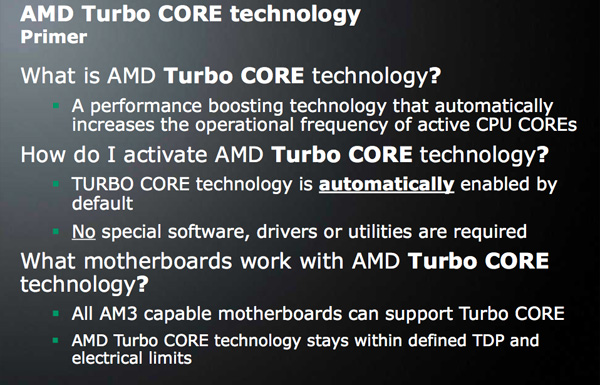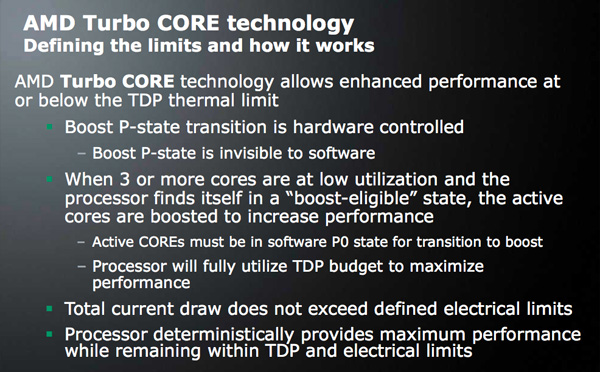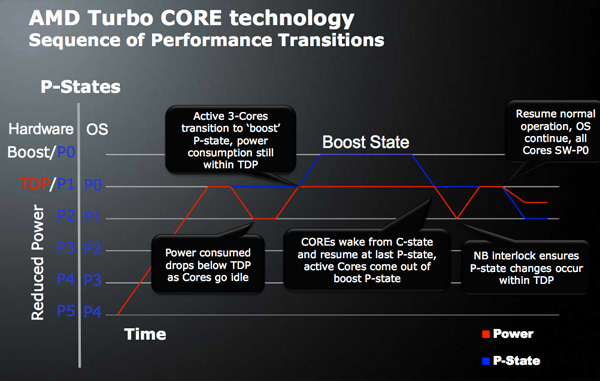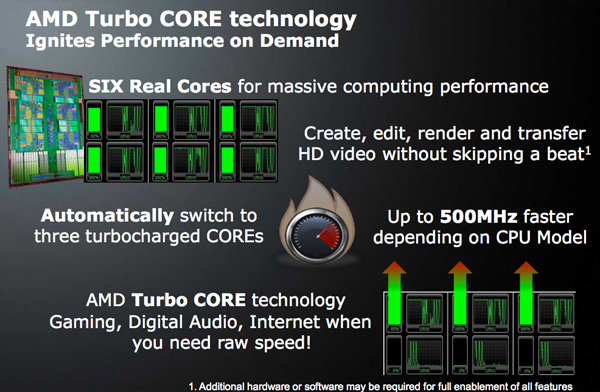AMD Divulges Phenom II X6 Secrets, Turbo Core Enabled
by Anand Lal Shimpi on April 8, 2010 12:00 AM ESTLast month Intel introduced its first desktop 6-core CPU, the 32nm Gulftown Core i7 980X. Running at 3.33GHz we loved the fact that it’s quite possibly the first Extreme Edition part that is able to justify its price. For $999 you get six cores and better performance all in the same power envelope as the current high end quad-core i7s.
The 980X is a great chip, but spending $999 on a single component in your PC is a tough sell for most folks. Luckily, AMD is coming out with its own 6-core processors codenamed Thuban. Below is what we know so far about AMD's Thuban lineup (note, the information in the table was not provided by AMD):
| AMD 2010 Roadmap | |||||||
| CPU | Clock Speed | Max Turbo (<= 3 cores) | L3 Cache | TDP | Release | ||
| AMD Phenom II X6 1090T | 3.2GHz | 3.6GHz | 6MB | 125W | Q2 | ||
| AMD Phenom II X6 1075T | 3.0GHz | 3.5GHz | 6MB | 125W | Q3 | ||
| AMD Phenom II X6 1055T | 2.8GHz | 3.3GHz | 6MB | 125W/95W | Q2 | ||
| AMD Phenom II X6 1035T | 2.6GHz | 3.1GHz | 6MB | 95W | Q2 | ||
| AMD Phenom II X4 960T | 3.0GHz | 3.4GHz | 6MB | 95W | Q2 | ||
Officially branded the Phenom II X6, AMD won’t be launching these processors until some time in the future. But today AMD is disclosing some basic details about the parts. We’re also mixing in our knowledge of internal AMD roadmaps to paint a clear picture of AMD’s 6-core strategy.
The more cores at the same TDP feature that Intel delivers with the 980X, AMD is also promising with Phenom II X6. The difference is that these are still 45nm parts. While we’ll have to test them to be sure, AMD currently indicates that the entire Phenom II X6 lineup will be rated at 95W or 125W TDPs. It’s all manufacturing tricks that make it possible (good job GlobalFoundries). In theory you should be able to buy a Phenom II X6 and have it operate in the same power envelope as a Phenom II X4 965.

With the Thuban cores AMD is introducing its version of Intel’s Turbo Boost technology called Turbo Core. AMD has yet to implement power gating on its processors, so Turbo Core works a little differently than Intel’s Turbo.
Turbo Core kicks in when 3 or more cores (on a 6-core part) are idle. When this happens, the frequency of those three cores is reduced to 800MHz, the voltage to the entire chip is increased, and the remaining three cores are turboed up by as much as 500MHz. It doesn’t get any more granular than this. If you have 3 or more cores idle, then the remaining turbo up. In any other situation the CPU runs at its normal clocks.

The CPU handles all monitoring and does the clock/voltage management itself. The switch to turbo up cores apparently happens fast enough to deal with Windows moving threads around from core to core.

Turbo core is triggered by a deterministic system that is based on load demand and current operating conditions (not temperature).
Cool’n’Quiet is active throughout the turbo process. What actually happens is that when CnQ looks to see if a set of cores should be downclocked, it also has the ability to increase the frequency of other cores.

This isn’t nearly as elegant of a solution as Intel’s turbo. The idle cores are never actually shut off, and voltage to all cores is increased to reach the higher clock speed. However if it works as advertised with no drawbacks (e.g. underclocking 3 cores when you actually still need them) then it’s definitely better than nothing for the Phenom II lineup. AMD will also have quad-core CPUs with turbo core support based on the new Thuban cores.
The great news? All Socket-AM3 and AM2+ motherboards will work with these new Phenom II X6 CPUs with nothing more than a BIOS update. The boards do have to support the TDPs the chips are rated for of course.
Pricing and performance are both unknowns at this point. We’ll keep you posted!










58 Comments
View All Comments
strikeback03 - Friday, April 9, 2010 - link
Yeah, I mean who could possibly want more speed when you are already using all four cores? *rolls eyes*ash9 - Thursday, April 8, 2010 - link
seems to me this speaks volumes to their 'M-Space' designsPessimism - Thursday, April 8, 2010 - link
Officially branded the Phenom II X6, AMD won’t be launching these processors until some time in the future.I stopped reading there.
Dzban - Thursday, April 8, 2010 - link
No need to. It is supposed to launch 24th of April.phenom_x8 - Friday, April 16, 2010 - link
WHy there is still no review about this new processor?? Anand, ha you ever check that in my country, it have been around for quite some time, especially the 1055T and 1035 T since 12th of April. A lot of people also sell it on many forum only for $218 . This is the link http://www.kaskus.us/showthread.php?t=3876654 (Sorry, its in Indonesian)REVIEW PLEASE, IMPORT IT IF YOU HAVE TO (Dont wait for any sample from AMD)
phenom_x8 - Friday, April 16, 2010 - link
WHy there is still no review about this new processor?? Anand, have you ever check that in my country, its have been around for quite some time(12th of April), especially the 1055T and 1035 T .A lot of people also sell it on many forum only for $218 . This is the link http://www.kaskus.us/showthread.php?t=3876654 (Sorry, its in Indonesian)
REVIEW PLEASE, IMPORT IT IF YOU HAVE TO (Dont wait for any sample from AMD)
vol7ron - Thursday, April 8, 2010 - link
This is interesting - I've never purchased an AMD CPU, but I might give it a try.I'm curious why AMD decided that the voltage needed to go up. If some cores are not being utilized, then the current should flow to the used cores. Is this what you mean by power gating?
Also, my memory does not serve me as well as it used to. With all these new processors, I thought it was advised to get three sticks of RAM for maximum performance. I'm not sure if that was catered to the 3 or 6 core CPUs, or if it had something to do with the North Bridge. Perhaps someone could clear this up for me?
Thanks,
vol7ron
Taft12 - Thursday, April 8, 2010 - link
The 3-sticks-of-RAM floating around in your head is from the triple-channel architecture of Intel's socket-1366 Core i7 platform. Barely any benefit over dual-channel, but 6 slots in the motherboards are very nice!Zaitsev - Saturday, April 10, 2010 - link
"I'm curious why AMD decided that the voltage needed to go up. If some cores are not being utilized, then the current should flow to the used cores. Is this what you mean by power gating?"That is exactly what intel does, and I think that IS the reason AMD can't use the same method. You know Intel has patents on the powergate tech.
But you're right, it makes more sense to decrease voltage to the un-used cores.
ltcommanderdata - Thursday, April 8, 2010 - link
Maybe this will finally push Intel to release mainstream Gulftown's either 6 cores or harvested quad cores to replace the Bloomfield Core i7. Bloomfield's 1 or 2 multiplier Turbo Boost and consistent high 130W TDP even on the lower-end models isn't very impressive compared to Lynnfield and now Thuban.